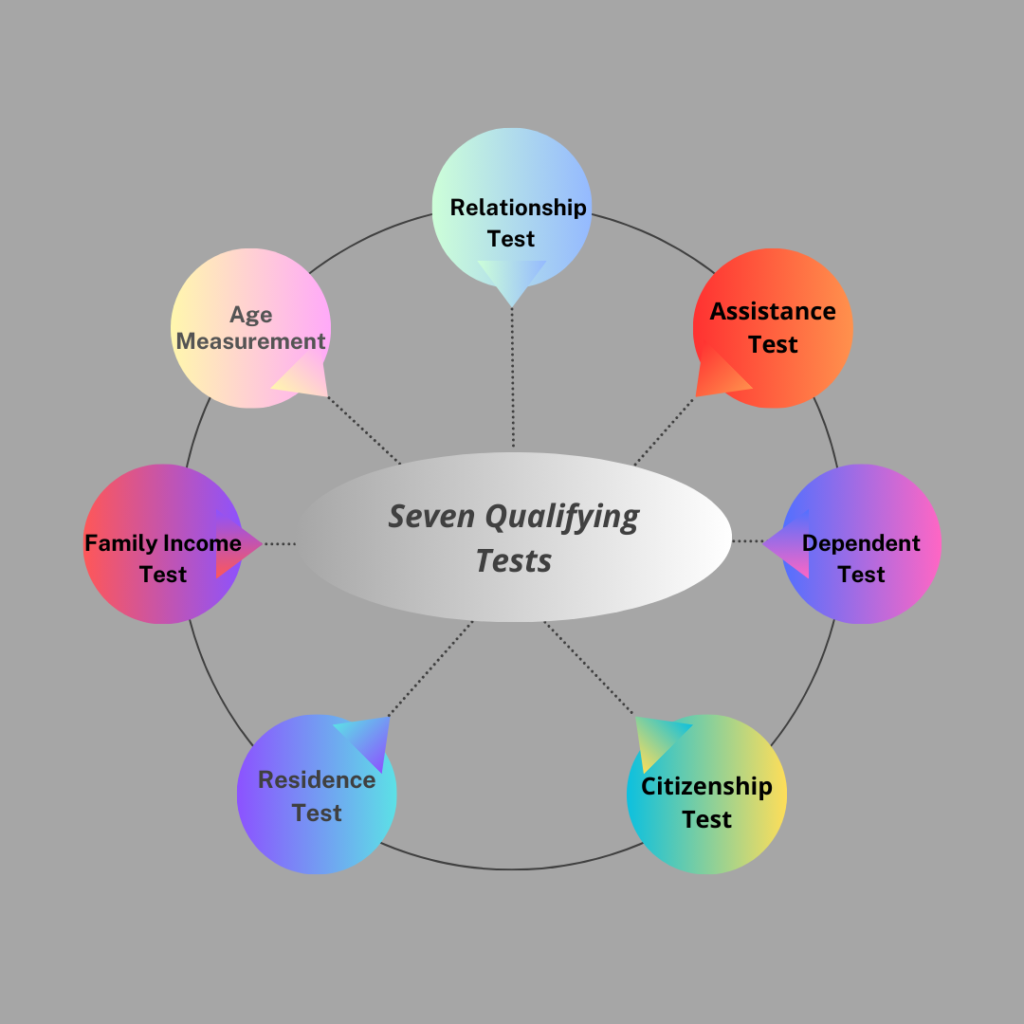Table of Contents
Key Points:-
- To assess eligibility for the Child Tax Credit, there are seven qualifying tests: age, relationship, support, dependent status, citizenship, duration of residency, and family income.
- Your dependant may be qualified for the Child Tax Credit under a different guardian if you are unable to claim the credit for one of them.
- The American Rescue Plan Act temporarily directed the IRS to give advance payments for the 2021 Child Tax Credit during 2021, instead of waiting for households to submit their 2021 taxes in 2022.
- A complete refund of the Child Tax Credit for the year can be obtained as a temporary adjustment for 2021, even in cases where no federal income tax is due. This is due to an increase in eligibility and credit levels for some families.
Child Tax Credit for Tax Years 2023, 2022, 2020, and Earlier:- For these years, your child must pass all seven qualifying tests to be eligible for the Child Tax Credit.

- Age Measurement:- At the conclusion of the tax year in which you file your claim for the credit, your kid must be under the age of 17.
- Relationship Test:- The kid must be your biological child, your stepchild, or a foster child put in your care by a judge or other legally recognized organization. Children you adopt are always regarded as your own.
- Assistance Test:- During the tax year, the child’s own financial assistance cannot have accounted for more than half of the total.
- Dependent Test:- The youngster needs to be listed on your tax return as a dependent.
- Citizenship Test:- The kid must be a citizen, national, or permanent resident of the United States.
- Residence Test:- The child has to have spent more than half of the tax year residing with you.
- Family Income Test:- If your modified adjusted gross income (MAGI) is higher than a set amount, the Child Tax Credit is lowered.
Note:- There are exceptions for temporary absences, such as school, vacation, business, medical care, military service, or juvenile imprisonment, during which the child is still deemed to be living with you. Special restrictions apply to children born or killed during the tax year.
| TurboTax Tip:- You might be able to claim your dependent as well as be eligible for alternative dependent care credits if they don’t match the standards for the 2023 Child Tax Credit. |
Bill Belichick leaving the New England Patriots after 24 season
Lineup For Hangout Music Festival in 2024. It is an unforgettable experience.
What occurs if my 2023 tax liability is less than my credit?
The Child Tax Credit is not refundable for tax years 2023, 2022, 2020, and prior. Your tax liability is offset by your credit, and any credit that remains after that is forfeited. For the percentage that you don’t use, you might be able to claim an additional child tax credit.
Refunds of up to $1,600 are available for each eligible child in 2023. You can use the IRS Form 8812 worksheet to find out if you qualify for this refundable credit.
Child Tax Credit for 2021
The American Rescue Plan Act of March 2021 was created to help with the COVID-19 pandemic’s economic recovery. Through its expansion, the Child Tax Credit yielded more financial benefits and made it possible for eligible beneficiaries to obtain these benefits faster by means of improved monthly payments starting in 2021.
Payment of the Child Tax Credit in Advance
In March 2021, the American Rescue Plan Act allowed the Enhanced and Newly Expanded Child Tax Credit for 2021. Most families can receive their advance payment without doing anything, so they can avoid waiting until 2022 to balance their 2021 taxes. The IRS will normally use your 2020 tax return to determine the payment. The advance payment will be sent to qualified families by cheque or direct deposit.
The 2021 Child Tax Credit is being paid in advance with these installments. When you file your 2021 tax return in 2022, the amount you get will be compared to the amount for which you are eligible. About half of the Child Tax Credit will be paid to most families in advance. You will receive additional money on your tax return if the amount you receive is insufficient. If, according to your income level, you are unexpectedly given too much, you may have to refund the excess.
What recent changes have been made to the Child Tax Credit?

[Image Credit:-Tenor]
For the tax year 2021, the American Rescue Plan raised the maximum Child Tax Credit to $3,600 for children under the age of six and $3,000 for children between the ages of six and seventeen. Prior to 2021, minors 17 years of age and older were not eligible for the credit, which had a maximum limit of $2,000 per qualifying child.
The 2021 Child Tax Credit income threshold has also undergone modifications. Families can still claim the original Child Tax Credit of $2,000 per child using their modified adjusted gross income (MAGI) and phase-out the amount if they are not eligible for the credit utilizing these lower income limits.
Furthermore, the full credit is entirely refundable for 2021, which means that qualifying families can get a cash refund even if they do not owe any federal income tax.
In contrast to other years, there are no requirements regarding earned income in order to be eligible for the Child Tax Credit in 2021.
The youngster must be under 18 at the end of the year in order for the 2021 age test to be modified. The additional credit for children under the age of 18 is available to families with qualifying income levels, which are less than $75,000 for single filers, $112,500 for heads of household, or $150,000 for joint filers. Families earning more above these thresholds will see the credit phase out at $200,000 for single filers and $400,000 for joint filers, and the benefit will decrease by $50 for every $1,000 in income over the threshold.
The technique that offers you the most advantage determines the maximum credit you are eligible for.
In addition, until 2021, the Child Tax Credit is completely refundable. Your tax bill is reduced to zero and any unused credit can be refunded if your credit exceeds your tax burden.
The purpose of these adjustments is to give families more financial assistance during trying times. Consider speaking with a tax expert or contacting the IRS for more information if you need help or have any queries.
What is Other Dependent Credit?
If you have a dependent who doesn’t fit the standards for the Child Tax Credit in 2023, you may still be able to claim them as a dependent and qualify for the Other Dependent Credit.
The Other Dependent Credit is an alternative credit that can be claimed for dependents who meet the following conditions: – The dependent is a U.S. citizen, U.S. national, or U.S. resident alien.
– Neither the Child Tax Credit nor the Additional Child Tax Credit may be claimed for the dependent.
– The dependant will be claimed on your tax return.
– The dependent possesses an individual taxpayer identification number (ITIN) or social security number.
It’s crucial to remember that dependents are eligible for this credit at any age, with a $500 credit cap per dependent.
When can I expect to receive my credit and tax refund?
Refunds for those who filed online and selected direct deposit as their refund option are normally issued by the IRS in 21 days or fewer.
However, processing the refund could take longer if more scrutiny is required because of mistakes or inconsistencies. There may also be delays in submitting returns that include applications for the Additional Child Tax Credit.
You can use our tool to track your refund and see its current status.
With TurboTax Live Full Service, your taxes will be managed from beginning to end by a local professional who is aware of your particular circumstances. Or, when filing your own taxes, use TurboTax Live Assist to receive limitless assistance and guidance from tax professionals.
Additionally, TurboTax will still provide you with step-by-step guidance if you choose to file your taxes on your own. We promise 100% correctness and the highest possible return whether you file with us or independently.










